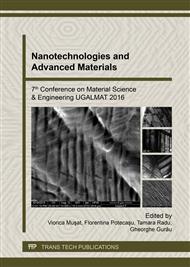p.3
p.7
p.13
p.20
p.26
p.32
p.38
p.45
Obtaining and Characterization of Ni-Ti Alloys Processed through Powder Metallurgy
Abstract:
This study presents the result of the researches regarding the obtaining of NiTi alloy through powder metallurgy (PM) as a possible alternative to present technologies (melting through induction in vacuum—MIV and re-melting with electric arch in vacuum—VAR). The researches made by the authors have aim at the obtaining of Ni-Ti materials with fine grain or ultrafine grain through powder metallurgy techniques, starting from ordinary metallic powders of Ti, Ni, Cu, with grain size less than 100 micrometers, and also using processing through severe plastic deformation (HPT — high pressure torsion). The fabrication through PM has an important advantage because a product requires low processing subsequent considering that it can get with sizes and shape very similar to the final ones, which is not negligible if one takes into account that the alloys Ni-Ti do not excel on cutting processability. Cylindrical samples were produced by cold uniaxial compression, at the specific pressure of 600 MPa, dosed in a proportion of 52.5 % Ni + 43.5 % Ti + 4.0 % Cu, mass composition. The compressed samples, after the sintering in vacuum and severe plastic deformation have been characterized by X-ray diffraction (XRD) , differential scanning calorimetry (DSC) and optical microscopy.
Info:
Periodical:
Pages:
13-19
Citation:
Online since:
February 2017
Keywords:
Price:
Сopyright:
© 2017 Trans Tech Publications Ltd. All Rights Reserved
Share:
Citation:


